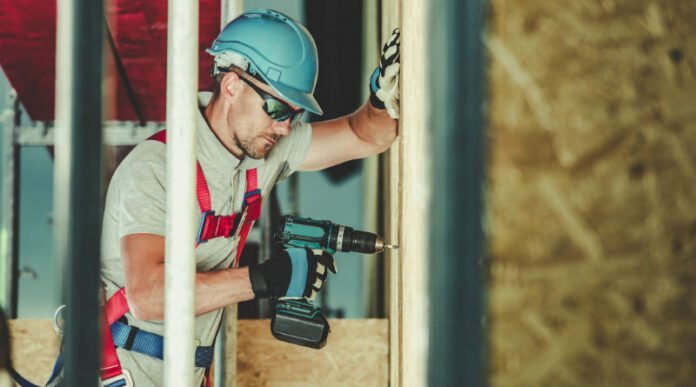Falls are the leading cause of jobsite deaths in the construction industry, and account for 30% of nonfatal injuries. Fall prevention is also the most frequently violated OSHA standard, according to the agency.
A webinar hosted by the Center for Construction Research and Training (CPWR) makes clear that it’s not just a fall that can be dangerous. Workers suffer serious health consequences when their fall arrest equipment works as expected.
Suspension trauma or hanging syndrome, also called orthostatic intolerance, occurs when workers suffer a fall but are saved by their harness. It’s caused by blood pooling in the veins, and can come on quickly.
RELATED: How to Design Safety Training Materials Workers Will Read
“Unconsciousness can occur in under one minute if conditions are appropriate,” Chad Riddleberger, captain and leader of the Technical Rescue Team at Roanoke Fire-EMS in Virginia, explained. “If you become unconscious and stop breathing, we have about six minutes to start providing some type of respiratory support. … After eight minutes, you become brain dead.”
Riddleberger described what happens to the human body when it is suspended in a fall protection harness.
“When we start having pooling of blood, it is starting to build up toxins in the body,” he said.
Early warning signs mimic the flu, including faintness, sweating, paleness, hot flashes, increased heart rate and nausea, he said. Over time, dizziness, slower heart rates, low blood pressure and loss of vision may set in.
Riddleberger noted that these are the same symptoms that occur during a trench collapse and a worker is pinned from the waist down.
Orthostatic intolerance doesn’t only happen after an arrested fall. Workers who stand for long periods of time without moving their legs may also suffer orthostatic intolerance. Riddleberger noted that anything that affects circulation, from blood pressure medications to dehydration, as well as environmental factors or a recent illness, can contribute to orthostatic intolerance.
‘Time is brain’
Education for builders’ entire crew is critical. As Riddleberger noted, from the time it takes rescue crews to get a call, arrive at the scene, find the injured person, analyze the situation and determine what needs to be done, and begin administering care, it could be as much as 30 minutes. Employers and workers need to understand how to react when a worker falls so that recovery efforts can begin immediately.
“If you can get yourself in what we consider the ‘position of refuge,’ you are buying time for yourself. Not only are you buying time for yourself, now you’re buying time for me,” he said.
“Time is brain,” he continued. The faster an unconscious person can be treated by experts, the better chance they have of full recovery.
He discouraged employers from putting a time limit on how long a worker can safely use the trauma straps on their harness while suspended. While the straps can buy time for workers, assuming they’ve been trained how to use them correctly, he said that “hanging from a harness is a dire medical emergency. It really doesn’t matter if it’s two minutes or two hours.”
What to do after a fall
Riddleberger said that any time employers have crews working in harnesses, they should have the ability to lower workers if they fall. If a worker does fall, employers should lower the worker as safely as possible; if that’s out of the question, try to raise them up to the level they were or provide a standing surface beneath them.
If workers have enough slack, they should try to move their legs, but Riddleberger warned they shouldn’t do anything to increase fatigue or raise their heart rates. Old advice to pedal their legs like they’re riding a bicycle is outdated, he said.
What not to do
If employers are able to lower workers, Riddleberger stressed that they shouldn’t allow any slack in the harness once they reach the ground or a level surface.
“Before they get on the solid surface completely, you need to make sure the thigh straps are tight,” he said. Essentially, he explained, you’re applying a tourniquet to prevent toxins that have built up in the blood from traveling through the body.
For the same reason, Riddleberger warned not to let workers sit up, but they also shouldn’t be fully reclined. Once a worker reaches the ground, lean them back into a 45-degree position.
“That way, the heart is not working so hard as when [the worker is] standing upright, and then if we lay them down … we don’t have a rush of the blood just automatically trying to come right back to the heart, into the lungs and the brain.”
Training and educating workers
While Riddleberger stressed that time is of the essence after a fall, Michael Kassman, a training specialist at CPWR, noted that training workers before a fall is critical.
“Even though you’ve got some of these solutions, the objective is preventing you from falling in the first place,” he said of fall arrest systems. He added that having someone on staff who is competent and qualified in fall prevention is invaluable. Fall arrest systems need to be inspected before every use, and if they’re ever deployed, they must immediately be removed from service, he explained.
Worker training should be ongoing, Kassman added. He noted there are over 90,000 components of fall prevention equipment on the market. If new systems come out, if previous training is made obsolete or if a worker actually falls, even if it’s just a close call, they need new training, he said.







